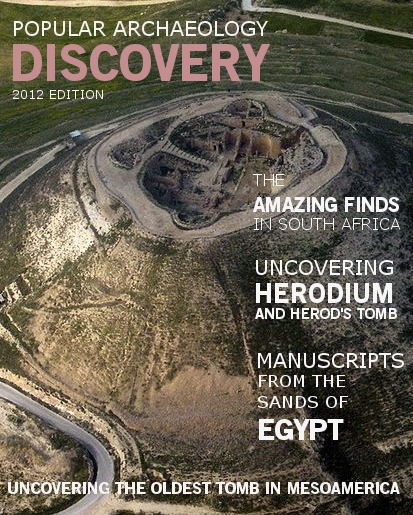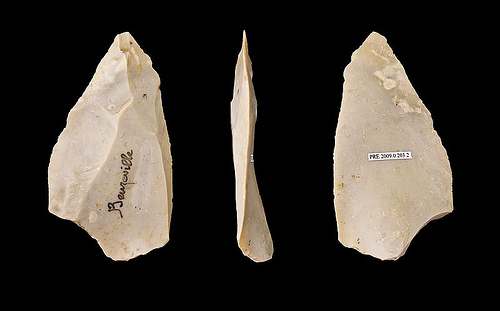
A team of Israeli scientists have reported the discovery of a hominin (early human) occupation site near Nesher Ramla, Israel. The site, according to archaeologist Yossi Zaidner of the Zinman Institute of Archaeology at the University of Haifa and colleagues, presents evidence for human occupation or use during Middle Paleolithic times (about 300,000 to 40 – 50,000 years ago).
Unearthed were numerous finds that comprised an 8-meter deep sequence of “rich and well-preserved lithic [worked stone tool artifacts] and faunal assemblages [animal and early human bones], combustion features [features evidencing use or presence of fire], hundreds of manuports [natural objects moved from their original locations possibly by human agency] and ochre.”* Ochre, an iron oxide pigment, was often used for a variety of purposes by prehistoric humans, including the creation of wall paintings.
Using the optically stimulated luminescence (OSL) dating technique, the researchers were able to place habitation or use of the site during the MIS (Marine Isotope Stage) 6-5, or a date range between about 190,000 and 74,000 years ago. Although the type of human was not identified as yet in their report, this time period witnessed activities of both Neanderthals and early modern humans. The lithic artifacts were of the Mousterian tradition, and included Levallois cores, flakes, points, and side-scrapers. They also discovered a “vertebral column in anatomic articulation” and “probable cutmarks observed in the field on an aurochs-sized long bone shaft fragment”.* The auroch is a large, extinct type of wild cattle that inhabited Europe, Asia and North Africa.
_________________________________________________________________________________________
Above: Typical example of a Levallois point, found in Beuzeville, Eure, France. Didier Descouens, Wikimedia Commons
_________________________________________________________________________________________
Summarizes Zaidner, et al.: “The site, found within a karst depression at Nesher Ramla, Israel, provides novel evidence for Middle Paleolithic lifeways in an environmental and depositional setting that is previously undocumented in the southern Levant. The carbonate bedrock in the area is characterized by surface depressions formed by gravitational sagging of the rock into underlying karst voids.”*
Karst features such as depressions and caves are naturally caused by water action over time with carbonate rock, such as limestone and dolomite. Israel features a number of such caves, some of which have revealed evidence of human habitation by Neanderthals and other early human species. Kebara cave near Zikhron Ya’akov, for example, has yielded fossilized 60,000-year-old remains of a Neanderthal and lithic artifacts; and the Tabun Cave, near Mount Carmel, contained a Neanderthal-type female dated to about 120,000 years ago.
The details of the report, currently in press, are documented in the Journal of Human Evolution.
___________________________
* A series of Mousterian occupations in a new type of site: The Nesher Ramla karst depression, Israel
________________________________________________________________________________________________________________________
Read about the most fascinating discoveries with a premium subscription to Popular Archaeology Magazine. Find out what Popular Archaeology Magazine is all about, including the special Holiday Discount offer. AND MORE:
 On the go? Purchase the mobile version of the current issue of Popular Archaeology Magazine here for only $2.99.
On the go? Purchase the mobile version of the current issue of Popular Archaeology Magazine here for only $2.99.
And, Popular Archaeology’s annual Discovery edition is a selection of the best stories published in Popular Archaeology Magazine in past issues, with an emphasis on some of the most significant, groundbreaking, or fascinating discoveries in the fields of archaeology and paleoanthropology and related fields. At least some of the articles have been updated or revised specifically for the Discovery edition. We can confidently say that there is no other single issue of an archaeology-related magazine, paper print or online, that contains as much major feature article content as this one. The latest issue, volume 2, has just been released. Go to the Discovery edition page for more information.
Subscription Price: A very affordable $5.75 for those who are not already premium subscribers of Popular Archaeology Magazine (It is FREE for premium subscribers to Popular Archaeology). Premium subscribers should email [email protected] and request the special coupon code. Or, for the e-Book version, it can be purchased for only $3.99 at Amazon.com.






